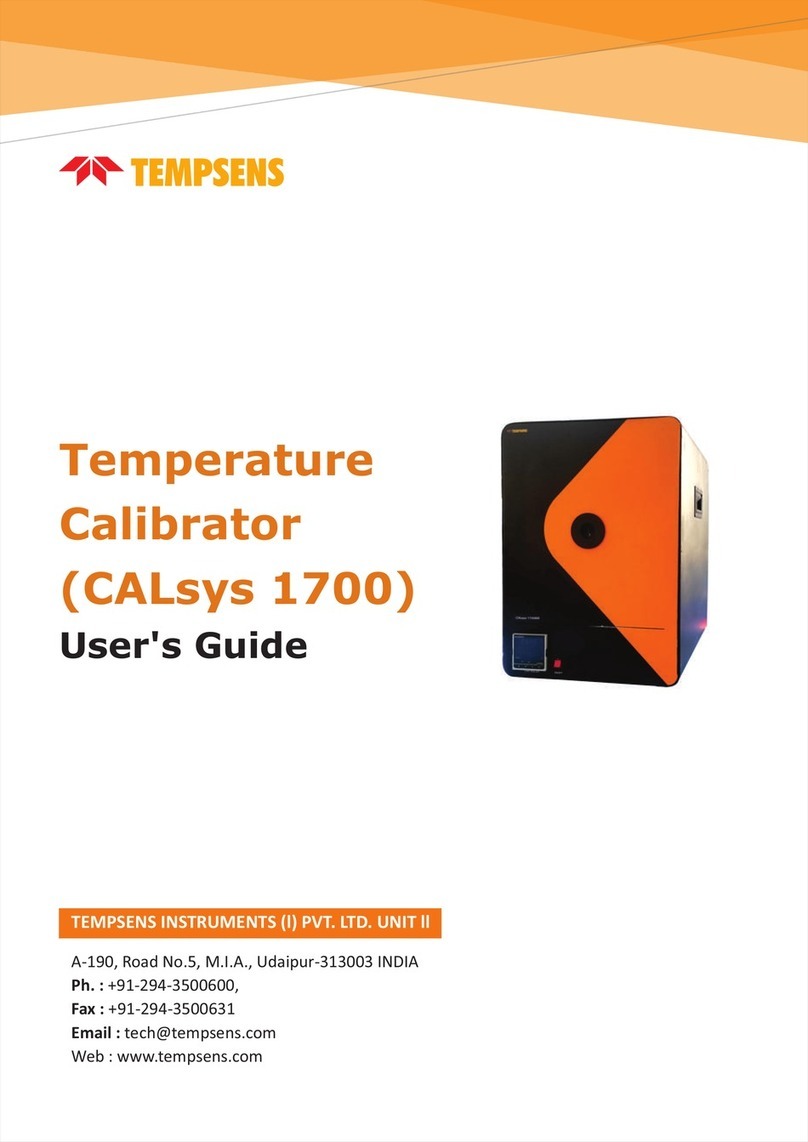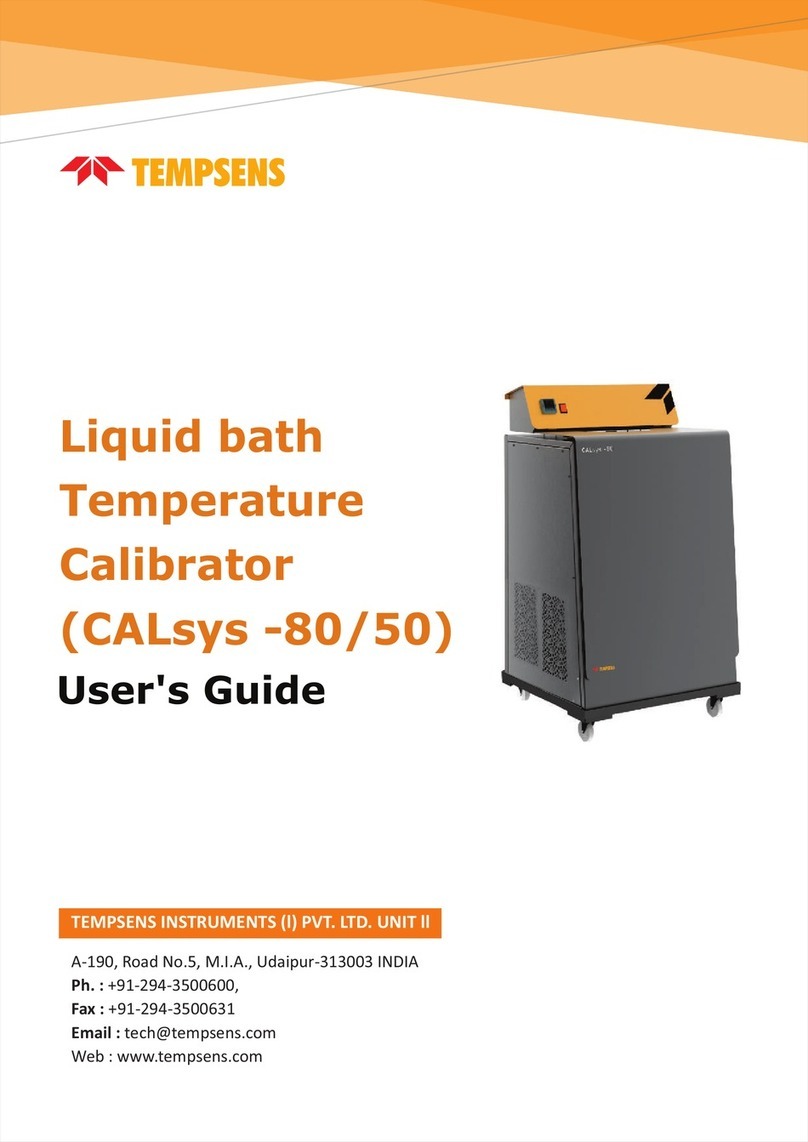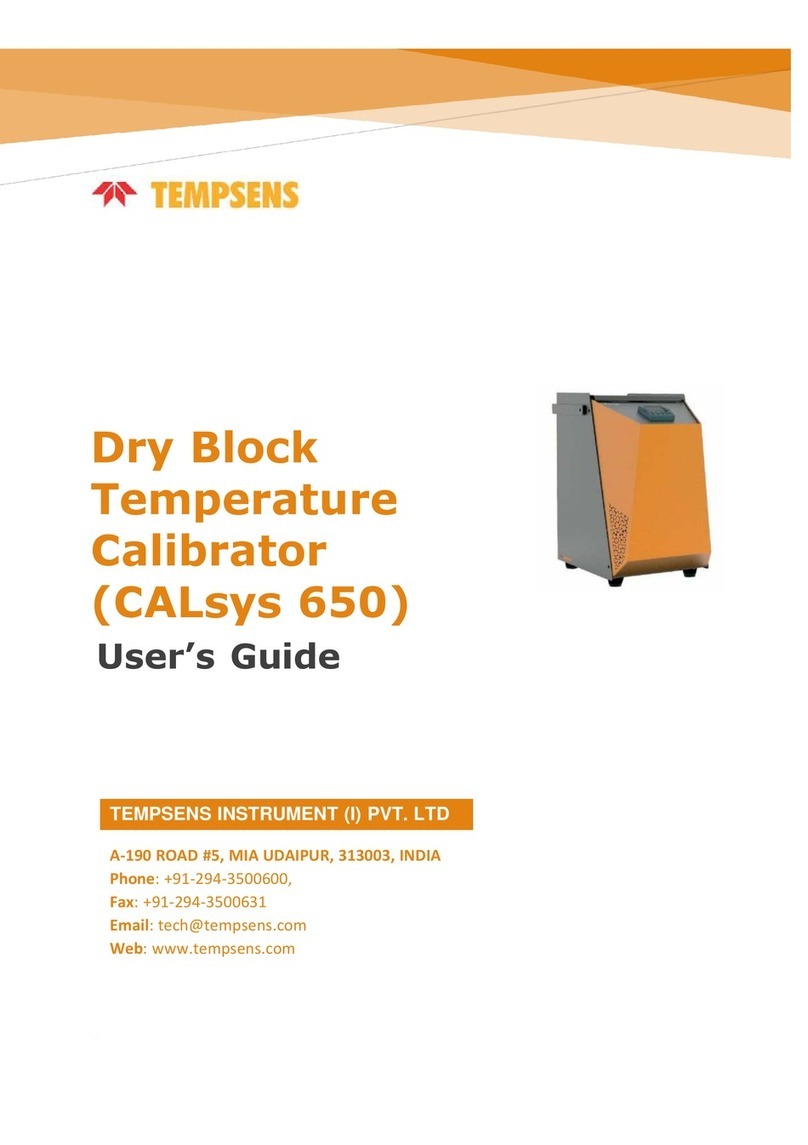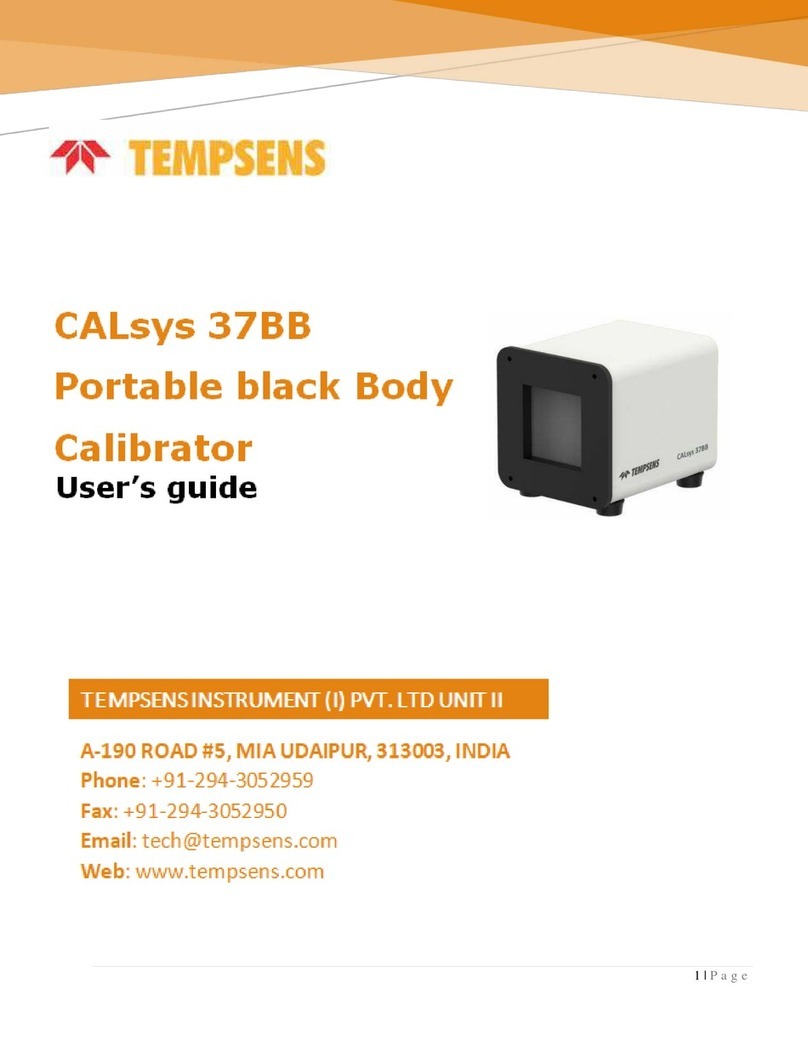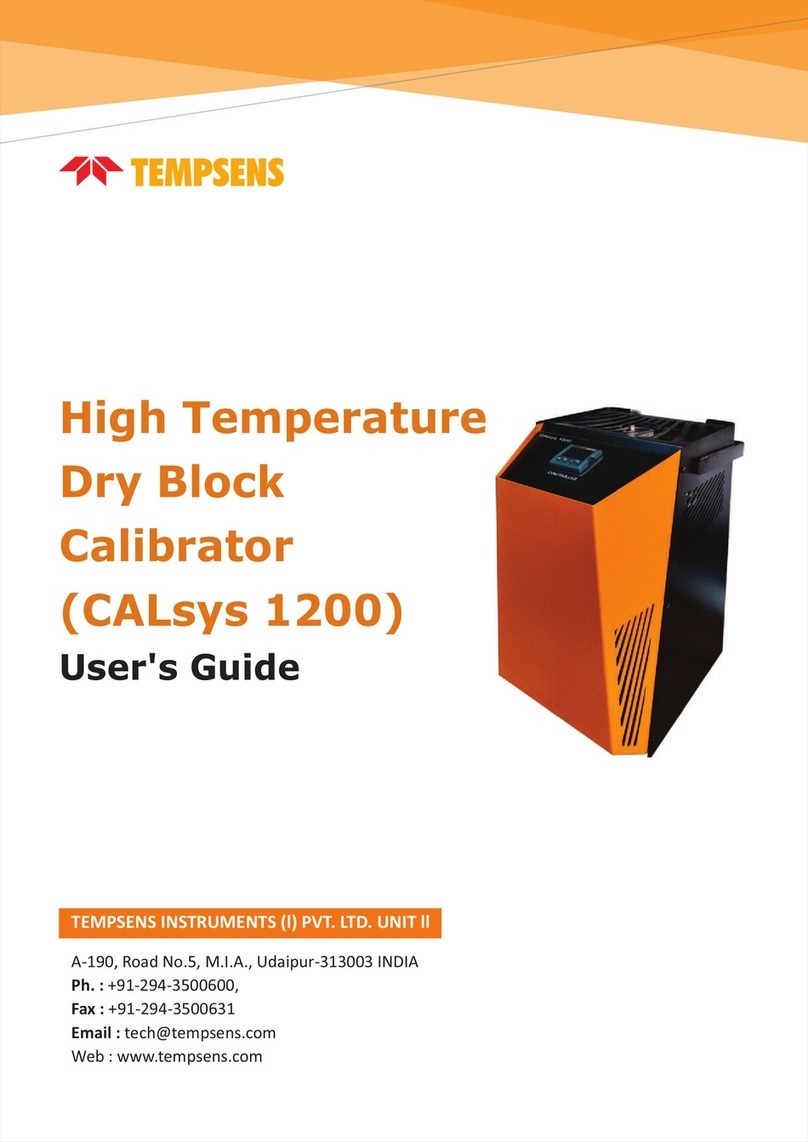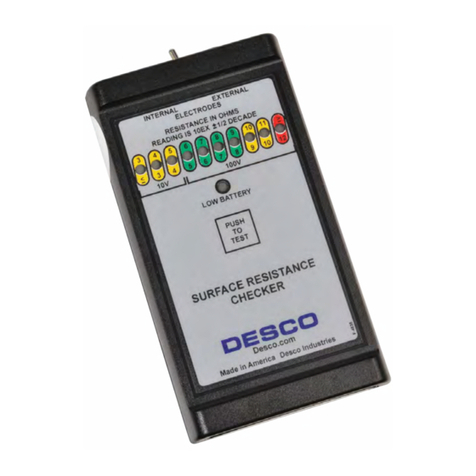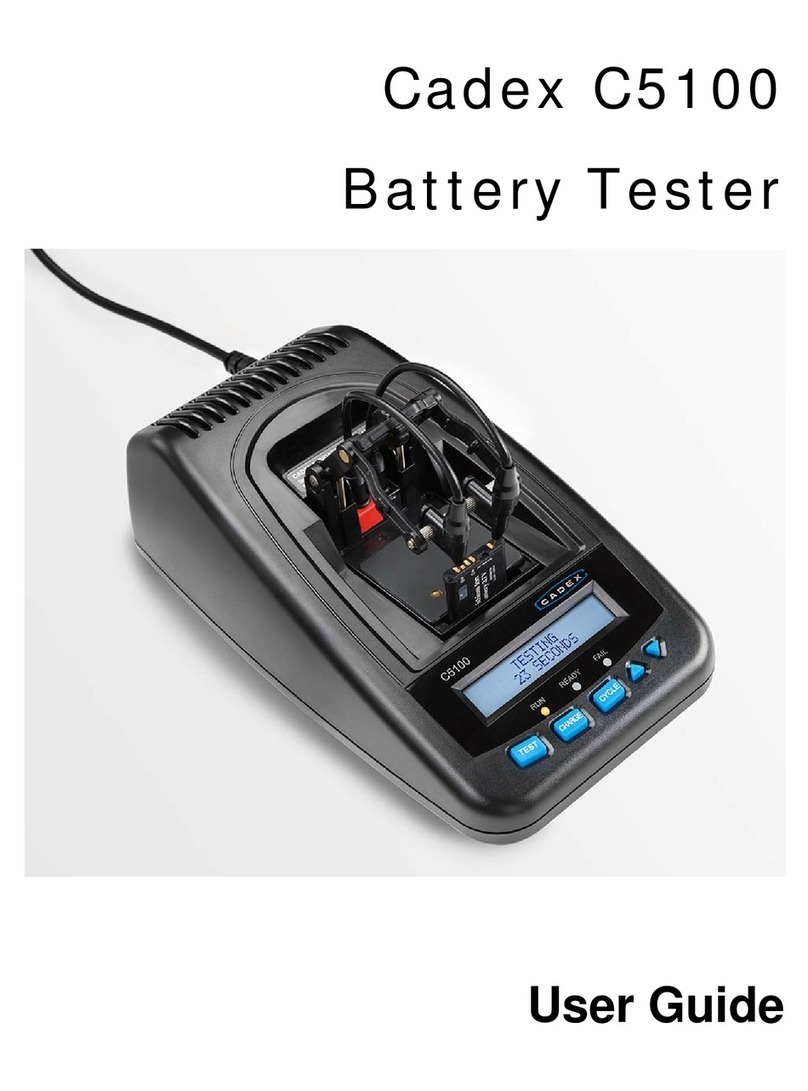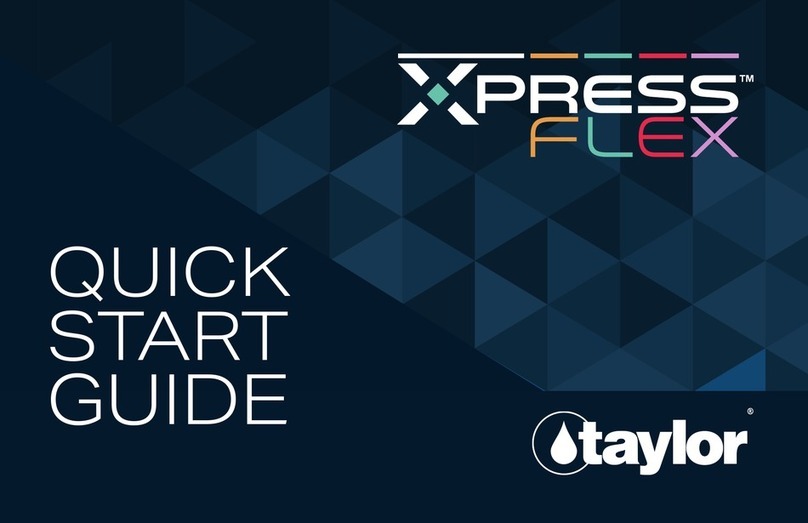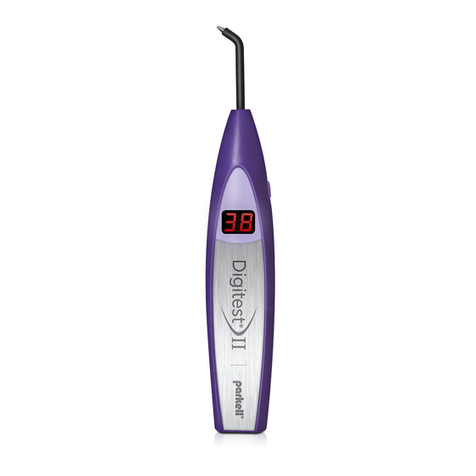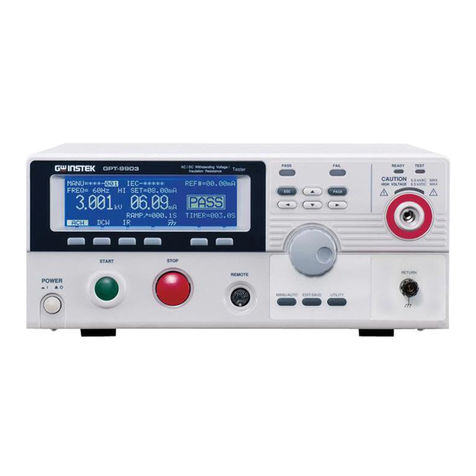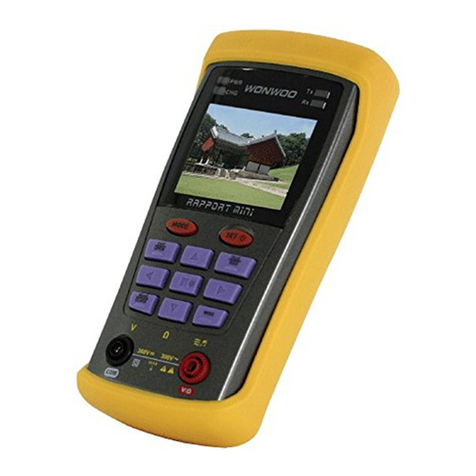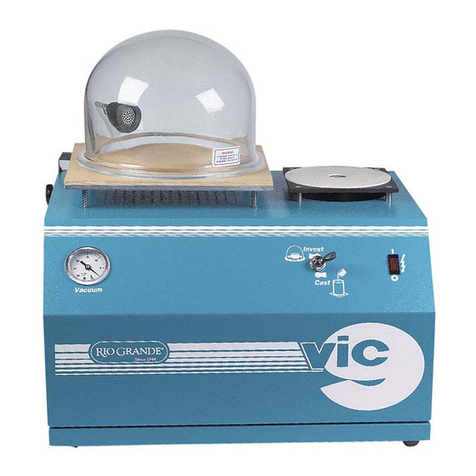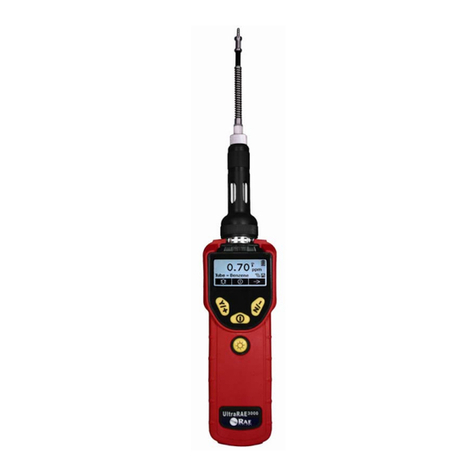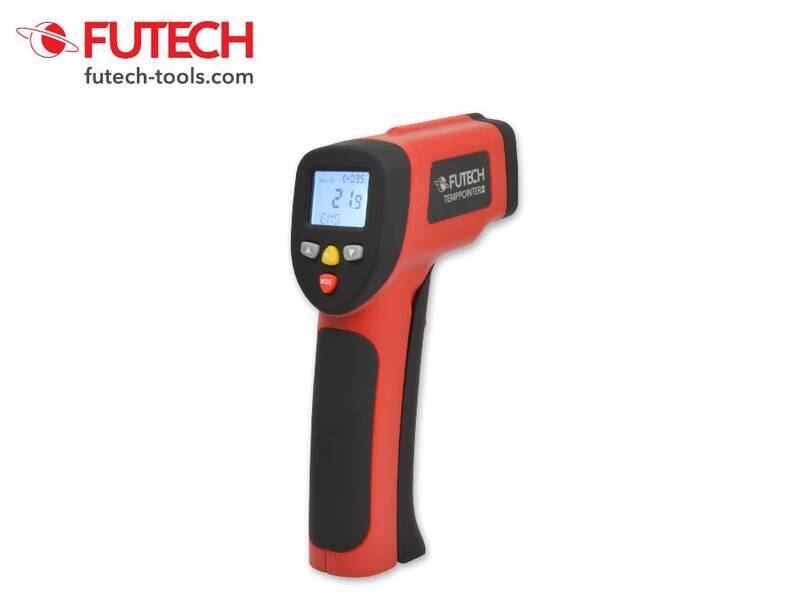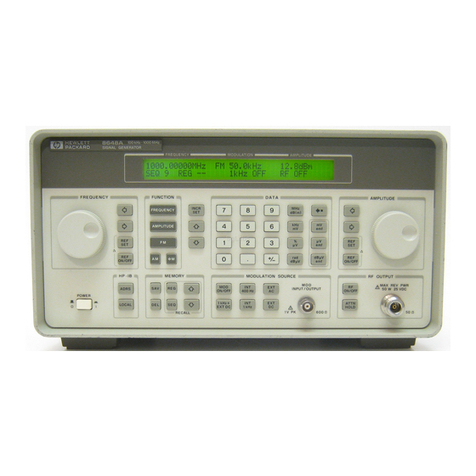Tempsens CALsys-40 User manual

1
C
CA
AL
Ls
sy
ys
s
-
-4
40
0/
/5
50
0
Liquid Temperature Calibrator
USER MANUAL
TEMPSENS INSTRUMENT (I) PVT. LTD UNIT II
A-190 ROAD NO. 5 MIA UDAIPUR 313003 INDIA
TEL. +91 294 3052959, FAX +912943052950
Em il: tech@tempsens.com
Web: www.tempsens.com

2
Contents
1Introduction 5
1.1 Basic working
1.2 Dimension
1.3 wiring
2 Technical Data 7
2.1 Technical specification
3 Environmental condition 8
4 Unpacking 8
4.1 Initial Inspection
5. Operating Instruction 9
5.1 Power
5.2 Setting the temperature
5.3 Operating Instruction
6. Operation of Controller 11
6.1 The Temperature Controller
6.2 Altering the set point
6.3 Monitoring the Controlling Status
6.4 Units
7. Software Installation 13
7.1 Installati on
7.2 Para meter in main screen
8. Maintenance & Trouble shooting 16
8.1 Maintenance
8.2 Troubleshooting
9. Troubleshooting 17

3
Preface
Thank you for purchasing High Quality and Efficient CALsys -40/50.
Please familiarize yourself with the information contained in the safety precautions sections before using this
product.
This user manual contains information about the product and its proper use and should be kept in a place
where it will be easy to access.
1. Safety Information
Use the instrument only as specified in this manual. Otherwise, the protection provided by the instrument
may be impaired. Refer to the safety information below and throughout the manual.
The following definitions apply to the terms “Warning” and “Caution”.
•“Warning” identifies conditions and actions that may pose hazards to the user.
•
“Caution” identifies conditions and actions that may damage the in strument bei n g
used.
ELECTRICAL SAFETY
To avoid possible electric shock or personal injury, follow these guidelines.
•This equipment must be correctly earthed.
•A protective earth is used to ensure the conductive parts cannot become live in the event of a failure
of the insulation.
•The protective conductor of the flexible mains cable which is colored green/yellow MUST be
connected to a suitable earth.
•Do not use the apparatus outside its recommended range i.e., -40 to 50° C.
•Before connecting to the electricity supply, please familiarize yourself with the parts of the calibrator
with the help of operating manual.
•Always replace the fuse with one of the same rating, voltage and type.
•Replace the mains power cord if the insulation is damaged or if the insulation shows signs of wear.
•Do not put the Product where access to the mains power cord is blocked.
•Do not use an extension cord or adapter plug.
•Do not use the Product if it operates incorrectly.
•Make sure the power cord does not touch with hot parts of the Product.
HEALTH AND SAFETY INSTRUCTIONS

4
•Wear appropriate protective clothing.
•Operators of this equipment should be adequately trained in the handling of hot and cold items and
liquids.
•Do not use the apparatus for jobs other than those for which it was designed, i.e. the calibration of
thermometers.
•Do not handle the apparatus when it is hot (or cold), unless wearing the appropriate protective
clothing and having the necessary training.
•Do not drill, modify or otherwise change the shape of the apparatus.
•Do not use the apparatus outside its recommended temperature range.
•If cased, do not return the apparatus to its carrying case until the unit has cooled.
•There are no user serviceable parts inside. Contact Tempsens agent for repair.
•Ensure materials, especially flammable materials are kept away from hot parts of the apparatus, to
prevent fire risk.
•Do not use the Product around explosive gas, vapor, or in damp or wet environments.
•Make sure that the space around the Product meets minimum requirements.
•Do not keep the Product in operation and unattended at high temperatures.
•Do not set anything on top of the Product. Very high temperatures can cause the ignition of
flammable materials.
•BURN HAZARD - DO NOT touch the well access surface of the unit.
•DO NOT turn off the unit at temperatures higher than 100°C. This could create a hazardous situation.
Select a set-point less than 100°C and allow the unit to cool before turning it off.
•Materials used in this furnace may be irritating to skin, eyes, and respiratory tract. Consult the
material manufacturer’s MSDS (Material Safety Data Sheet).
•HIGH VOLTAGE is used in the operation of this equipment. SEVERE INJURY OR DEATH may
result if personnel fail to observe safety precautions.
•The top sheet metal of the furnace may exhibit extreme temperatures for areas close to the well
access.
CAUTIONS
To avoid possible damage to the instrument, follow these guidelines.
•Before working inside the equipment, turn the power off and disconnect the power cord.
•Overhead clearance is required. DO NOT place this instrument under a cabinet or other
structure.
•DO NOT turn the unit upside down with the inserts in place; the inserts will fall out of the unit.
•Use of this instrument at HIGH TEMPERATURES for extended periods of time requires

5
caution.
•Completely unattended high temperature operation is not recommended for safety reasons.
•DO NOT plug the unit into 230 V if the heater switches and fuse holder read115 V. This action
will cause the fuses to blow and may damage the instrument.
•Components and heater lifetime can be shortened by continuous high temperature operation.
•DO NOT use fluids to clean out the well.
•Never introduce foreign material into the probe hole of the insert. Fluids, etc. can leak into the
calibrator causing damage.
•DO NOT change the values of the calibration constants from the factory set values. The correct
setting of these parameters is important to the safety and proper operation of the calibrator.
•DO NOT drop or force the probe stems into the well. This type of action can cause a shock to the
sensor and affect the calibration.
Chapter – 1
1.1 Introduction:
The ‘Calsys -40/50’ has been designed to provide stable and accurate temperature to enable professionals to
calibrate Temperature Sensing Devices by comparison method. The ‘Calsys -40/50’ model has been
designed to be rugged and easily maintained. This model provides an isothermal enclosure in which the
thermocouple/RTD can be calibrated against the temperature of the calibrator. For traceable calibration a
master calibration sensor should be placed into the metal block alongside the unit under calibration.
The method is widely accepted because the calibrator provides very stable temperature nearing to its
controlled point, the Master Thermocouple / RTD, which is calibrated by independent Laboratory traceable
to National standards, compares the sensor under calibration.
The ‘CALsys’ models are part of wide range of portable calibrators designed and made by us. Please contact
us in case you required more information about our other products.

6
1.2 Basic Working:
‘The calibrator controller uses a PT-100 RTD as a controlling sensor and controls the well temperature with
MI heater. To obtain and maintain a required temperature the controller varies the power to the heater via
solid-state relay. There is one electricity driven fan which is situated under the heating chamber for cooling
the heater. ‘In Calsys -40/50, SS chamber with cooling media is cooled with compressed refrigerant gas
system. Temperature is controlled by MI heater in the chamber & PID controller. Cooling media is agitated
to keep homogeneous temperature. The user should be familiar with the safety guidelines and operating
procedures of the calibrator as described in the User’s Manual.
Dimension:
1.3 Wiring Diagram:

7
Chapter - 2
2. Tech ni cal Data
2.1 Tec hnical Specificati on
Voltage 230 VAC, (50 Hz)
Power 2 KW
Supply Frequency 50/60 Hz
Temperature range -40 to 50°C
Resolution 0.1 °C
Stability ± 0.05°C
Controlling sensor Precision PRT (PT-100)
Time to reach max. Temperature 60 Min ( room temperature to -40°C )
Operating Temperature 20 to 25 °C
Medium Methanol
Stabilization time 15 to 20 min
Method of controlling Digital self-tuned PID controller
Heaters MI Heater
Computer Interface RS-232
Dimensions 105 x 105 mm
Insert Construction 150 mm
Insert depth.
Weight Approximate 65Kg

8
Chapter – 3
3.1 Environmental Conditions:
Although the instrument has been designed for optimum durability and trouble-free operation, it must be
handled with care. The instrument should not be operated in an excessively dusty or dirty environment.
Maintenance and cleaning recommendations can be found in the Maintenance Section of this manual.
The instrument operates safely under the following conditions:
•Temperature range: 5 - 50°C (41 - 122°F)
•Ambient relative humidity: 15 - 50%
•Pressure: 75kPa - 106kPa
•Mains voltage within ± 10% of nominal
•Vibrations in the calibration environment should be minimized
•
Altitude less than 2000 meters
Chapter – 4
Unpacking
Our packing department uses custom designed packaging to send out your unit, but as accidents can still
happen in transit, you are advised, after unpacking the unit, to inspect it for any sign of damage, and confirm
that your delivery is in accordance with the packing note. If you find any damage or find any part missing
during delivery notify us and the carrier immediately. If the unit is damaged you should keep the packing for
possible insurance assessment.
After unpackin g you will find following items.
•
CALsys -40/50
•
RS -232 Cable
•
Manual
•
Certificates
•
Cera mic Wool

9
4.1 Initial Inspection:
1. Please open the carrying case carefully and takeout the operating manual from the box and read
carefully.
2. Take out the Bath carefully and keep it at suitable place.
3. Connect the power plug to the rear power entry and connect the power plug to the mains.
4. As soon as the power is ON (User main power panel) you shall observe display on the controller and
fan is ON. It shows that the bath is ready for use.
Note:
1. Please ensure that your unit is correctly connected to the electricity supply.
2. The apparatus must be correctly earthed (Grounded).
3. The unit’s ON/OFF switch is located on the power inlet. Take care NOT to switch the unit OFF when
it is hot – allow cooling first.
Chapter – 5
Operating Instruction
5.1 Power
Place the calibrator on a flat surface with at least 12 inches of free space around the instrument. Overhead
clearance is required. Do not place this unit
under a cabinet or structure. Fill the methanol (9 methanol) into the SS chamber. Plug the power cord into
mains outlet of the proper voltage, frequency typically this will be (230 VAC ±10, 50/60 Hz). Turn the
“Mains” (Heater) switch located on front panel. The controller display should illuminate after 3-4 sec. After a
brief self test the controller should begin normal operation. If the unit fails to operate please check the power
connection.
5.2 Setting the Temperature
Press “UP” or “DOWN” buttons to change the change the temperature set-point value. When the set-point
temperature is changed the controller will switch the Calsys -40/50 ON or OFF to raise or lower the
temperature. The displayed temperature will gradually change until it reaches the set point temperature. The
temperature bath requires 15 to 20 minutes to reach the set-point depending on the span. Another 10 to 15
minutes is required to stabilize the temperature bath within ± 0.1ºC of the set-point.
Note:
All other controller parameters are company set and locked. It is
recommended not to change them.
When the source is operated at any temperature above ambient, the front
face and plate become hot.

10
5.3 Testing
1. Fill the methanol (approx 6 ltr) into the chamber.
2. Connect the ‘Calsys -40/50’ to a suitable power supply & ON the Heater & Cooling Switch
temperature source and set the desire temperature value in PID by using UP & Down key.
3. Insert the reference (Master) temperature sensor and UUC (Unit under calibration) into the chamber.
4. PV (Present value) display in controller will gradually rise until it reaches the set point temperature. The
controller takes some times to reach the set-point depending on the span. Furnace is stable when PV is
equal to SV (Set Value).
5. Master sensor take some times to reach the setpoint temperature and stable at temperature near about
controller set temperature.
6. When temperature of the master and UUC (Unit under calibration) are stable record the readings of
master sensor.
7. Compare the UUC reading with the master’s reading & find out the error by comparison method.
8. Reset the controller and / or repeat the calibration for another calibration point or for another sensor.
9. When the calibration is complete, reset the controller to 0°C & wait until the unit has cooled to at
ambient temperature, before moving the ‘Calsys -40/50 to new location the ‘Calsys -40/50’ must be
cooled ambient temperature before it can be put back into its carrying case.
Chapter – 6
Operation of Controller
FRONT PANEL LAYOUT
Operator Buttons
(1) PID Controller
(2) ON/OFF switch of cooling
(3) Power Cable
(4) RS-232 output

11
6.1 The Temperature Controller
The controller has a dual display, the upper display indicates the measured temperature, and the lower
display indicates the desired temperature or set point.
6.2 Altering the Set point
To change the set point of the controller use the UP and DOWN keys to raise and lower the set point to the
required value. The lower display changes to indicate the new set point.
6.3 Monitoring the Controller Status
A row indicate the controllers status as follows
OP1 Heat Output
OP2 Cool Output
REM This beacon indicates activity on the PC interface
ALM this indicates when PV (Present value) is more than 50°C.
6.4 Units
Momentary pressing of the Scroll key will show the controller units °C or °F by using SCROLL key & UP &
DOWN key unit can be change.
IMPORTANT NOTICE
The controller's function settings are preset and will not require adjustment. Use only up & down key.
Digital Communications:
RS-232 is a standard communication protocol for linking computer and its peripheral devices to allow serial
data exchange. RS-232 communications uses the Modbus protocol. Rs-232 communications is not available
if Remote Set point is fitted. Cable screen should be grounded at one point only to prevent earth loops.
Digital Communications (or ‘comms’ for short) allows the controller to communicate with a PC or a
networked computer system.

12
Digital Communications Wiring
To use EIA232 the PC will be equipped with an EIA232 port, usually referred to as COM 1.To construct a
cable for EIA232 operation use a three core screened cable. The terminals used for EIA232 digital
communications are listed in the table below. Some PC's use a 25 way connector although the 9 way is more
common.
* These are the functions normally assigned to socket pins. Please check your PC manual to confirm.
Digital Communications Parameters
The following table shows the parameters available.

13
Chapter - 7
Software Installation
The provided Tempsens software offers possibilities to connect furnace temperature bath and change set
point, maximum time span, view real time graph and evaluate measuring data.
7.1 Installation
Install the calibration software using the installation guide file on CD ROM. After installation of the
software; Double click the application. It will open the screen of software.

14
7.2 Parameter in main screen
7.2.1 Communication
Communication between the furnace and the software is implemented via a RS-232 cable connected between
the furnace and the PC serial port. This enables the acquisition and recording of data, as well as the transfer
of commands from the software application to the Tempsens furnace. Communication can be done by
clicking on connect and select correct COM port address (fig. 1) where furnace is connected. Also user has to
select type of controller version3216 (fig. 2). Then click on CONNECT button. Shown com2 connected
successfully.
7.2.2 Scale Trend: -in scale trend you have to change the Y-Axis Min value 0 and Y-Axis Max value 50.
Maximum Time Span, Minutes have to save data the data logging up to 120 minutes, and then click on start
graph button. After complete the task click on save to file button.

15
Set Point (°C): - in which you can set temperature of furnace as your requirement.
PVI Value: - Read the current PV value (present value of furnace temperature).
File will be stored in .xls format to save previous record open the file by clicking on menu file open.

16
Chapter – 8
Maintenance & Trouble shooting
8.1 Maintenance
•The calibration instrument has been designed with the utmost care. Ease of operation and simplicity of
maintenance have been a central theme in the product development. Therefore, with proper care the
instrument should require very little maintenance. Avoid operating the instrument in an oily, wet, dirty,
or dusty environment.
•If the outside of the instrument becomes soiled, it may be wiped clean with a damp cloth and mild
detergent. Do not use harsh chemicals on the surface which may damage the paint.
•Avoid knocking or dropping the calibrator.
•
If the mains supply cord becomes damaged, replace it with a cord with the appropriate gauge wire for
the current of the instrument.
•Depending on the environment in which it is used, periodic cleaning is recommended. Cleaning may
be accomplished by the use of a small dry paint brush.

17
Chapter - 9
Trouble shooting
1. Unit fails to operate
Check fuse if it is tripped switch is ON. If not power ON of Calsys -40/50 bath consult us.
2. Unit unstable
Controller parameter has been interfered, consult us.
3. If the temperature of the calibrator is not rising
(a) The heating element may be open.
(b) The thermocouple may be open.
(c) The SSR may be damaged.
(d) The controller may not be giving output
(e) The ambient temperature inside the chamber is raised and safety controller switched OFF the power
Warranty
This instrument has been manufactured to exacting standards and is warranted for twelve months against
electrical breakdown or mechanical failure caused through defective material or workmanship, provided the
failure is not the result of misuse. In the event of failure covered by this warranty, the instrument must be
returned, carriage paid, to the supplier for examination and will be replaced or repaired at our option.
INTERF ERENCE WITH OR FAIL U RE TO P ROPERLY MAINTAIN TH IS
INSTRUM ENT MAY
INVALID THIS WARRANTY.
CAUTIONARY NOTE
TEMPSENS PRODUCTS ARE INTENDED FOR USE BY TECHNICALLY TRAINED AND
COMPETENT PERSONNEL FAMILIAR WITH GOOD MEASUREMENT PRACTICES.
IT IS EXPECTED THAT PERSONNEL USING THIS EQUIPMENT WILL BE COMPETENT WITH THE
MANAGEMENT OF APPARATUS WHICH MAY BE POWERED OR UNDER EXTREMES OF
TEMPERATURE, AND ARE ABLE TO APPRECIATE THE HAZARDS WHICH MAY BE ASSOCIATED
WITH, AND THE PRECAUTIONS TO BE TAKEN WITH, SUCH EQUIPMENT.

18
Information
Packing Instruction
To transport or store the instrument, please use the original box or a box padded with sufficient shock
absorbing material. For storage in humid areas or shipment overseas, the device should be placed in welded
foil (ideally along with silicon gel) to protect it from humidity.
Note: Please remove all packing sheets from inside and outer side of the chamber.
Warranty
TEMPSENS Calsys -40/50 instrument have a warranty of one year from the invoice date. This warranty
covers manufacturing defects. User induced faults are not covered under this warranty.
Limit of Liability
TEMPSENS not liable for any damages that arise from the use of any examples or processes mentioned in
this
Specifications are subject to change without notice
Copyright:@ 2009, TEMPSENS. All right
This document may contain proprietary information and shall be respected as a proprietary
document to TEMPSENS with permission for review and usage given only to the rightful owner of the
equipment with which this document is associated.
TEMPSENS reserves the right to make changes, without further notice, to any product
herein to improve reliability, function, or design . TEMPSENS does not assume any liability arising out of
the application or use of any product described herein, neither does it convey any license under its patent
right nor the right of others.
Copyright:@2009

19

20
TEMPSENS INSTRUMENT ( I) PVT. LTD
A-190 RO AD NO. 5 MIA U DAIPUR 313003 INDIA
TEL. +91 294 3052959
FAX +912943052 950
Email: tech@t empsens.com
This manual suits for next models
1
Table of contents
Other Tempsens Test Equipment manuals
Popular Test Equipment manuals by other brands
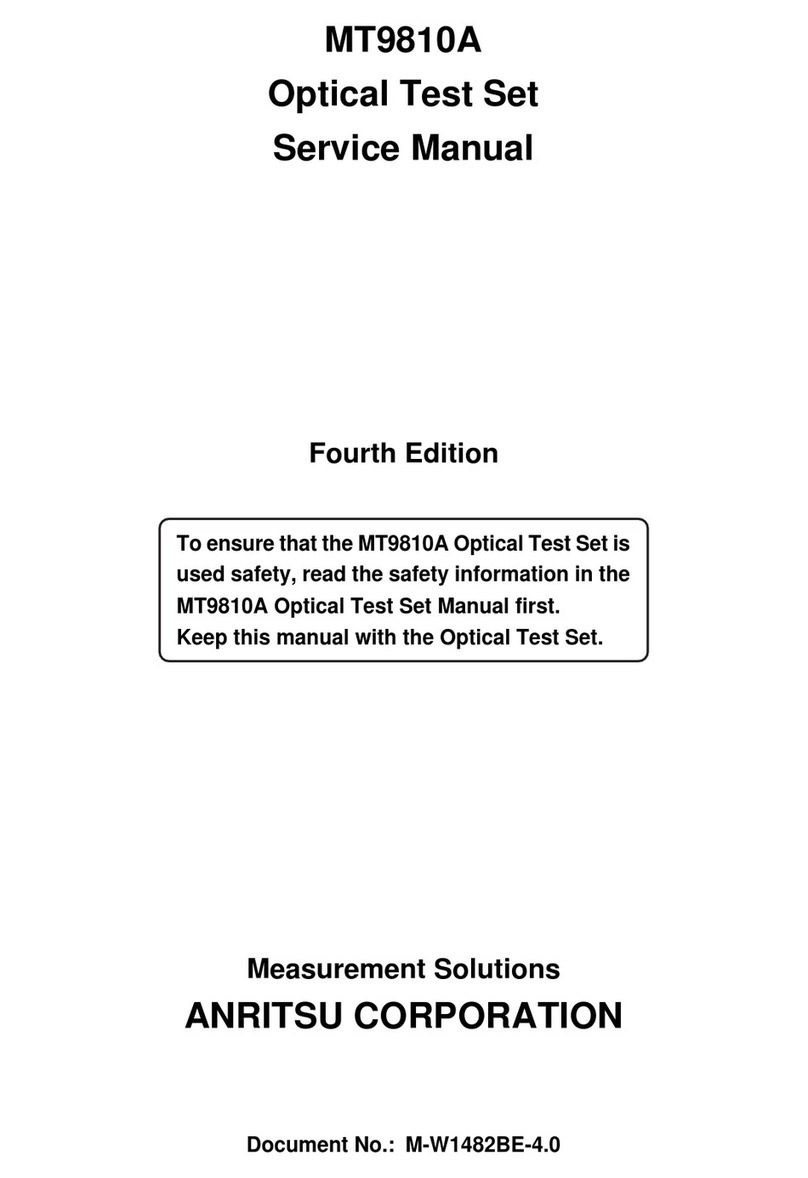
Anritsu
Anritsu MT9810A Service manual

PCB Piezotronics
PCB Piezotronics IMI SENSORS 699A05 Installation and operating manual
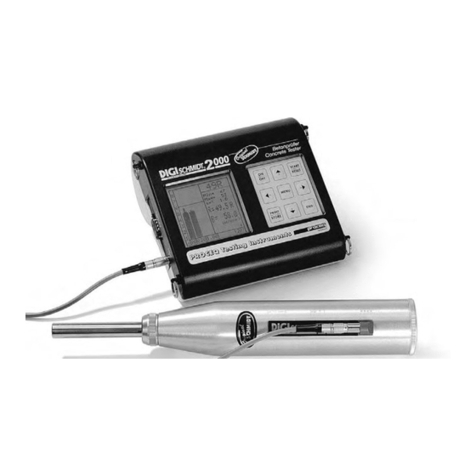
Proceq
Proceq DIGI-SCHMIDT 2000 ND operating instructions
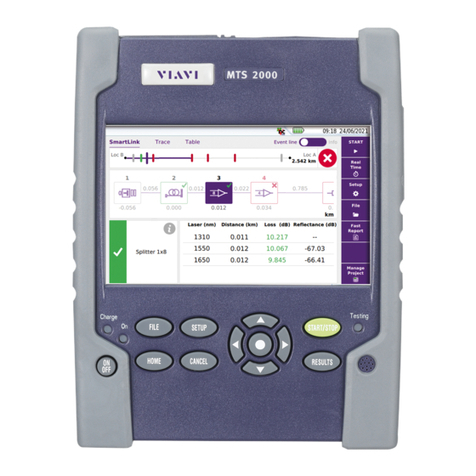
Viavi
Viavi MTS 2000 Quick Card

Mastech
Mastech KPS-TL300 instruction manual
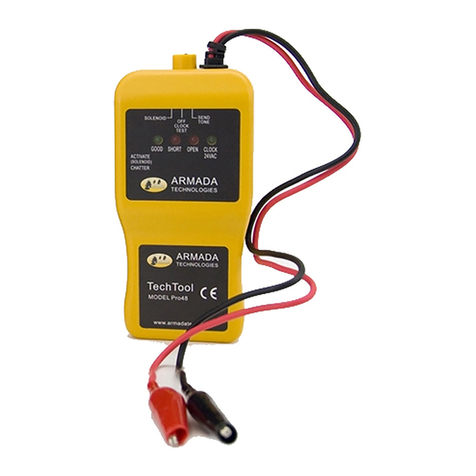
Armada Technologies
Armada Technologies Pro48 instruction manual

